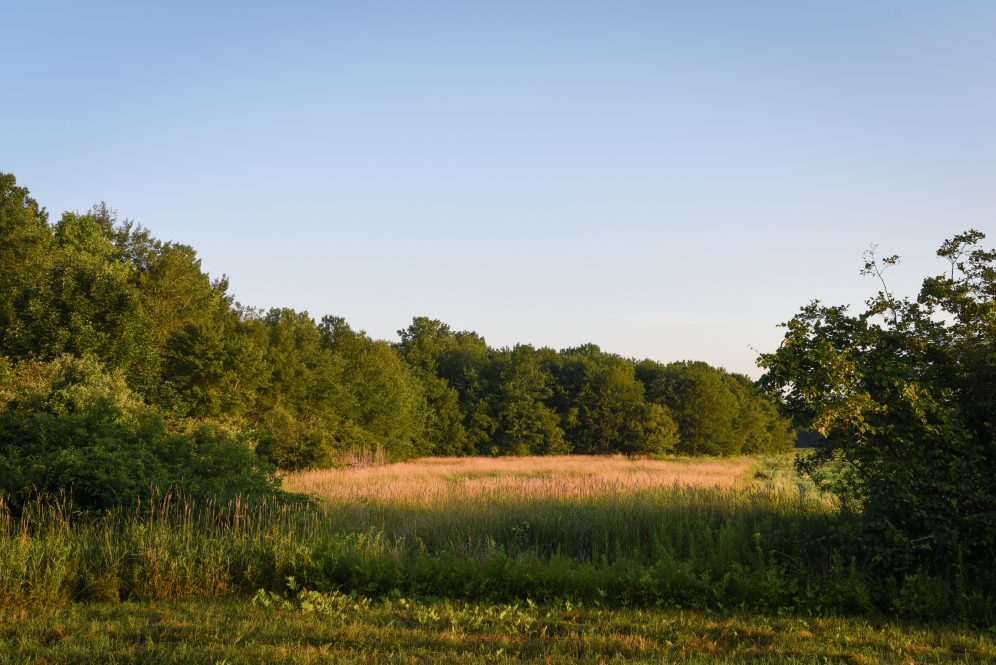Around 40% of forested land in the United States is privately owned, and for agencies tasked with preserving the nation’s natural resources, collaborations with private landowners are not just a vast opportunity, but a necessity.
To facilitate these collaborations and enhance the effectiveness of natural resource management, UConn researchers are taking a humanities approach to understand what influences private landowners to make conservation and stewardship plans.
Ava Smith ’16 (CAHNR) ’22 MS, Chadwick Rittenhouse, associate professor-in-residence and researcher in the Department of Natural Resources and the Environment, Eleanor Shoreman-Ouimet, an assistant professor in the Department of Anthropology, and Thomas Worthley, associate Extension professor of forest stewardship with UConn Extension, are working to understand these influences and motivations. Their findings are published in the Journal of Environmental Planning and Management.
Rittenhouse explains that he initially delved into these questions as a wildlife ecologist, knew the project needed a social science perspective, and felt Smith was the right person to spearhead the effort.
Agencies like state departments of the environment work with private landowners to develop management plans to encourage things like sustainable forest management, wildlife conservation efforts, or other land protection measures to introduce continuity in regional land management practices. However, landowners do not often do this, says Smith, in fact the last U.S. Forest Service National Woodland Owner Survey estimated only about 11% of all private landowners had a management plan in place.
“This means there is an untapped resource that can push the needle and improve conservation and natural resource land management protection overall,” Smith says. “That’s a very low percentage, and if that percentage is so low, then what are we doing and what aren’t we doing?”
These are important trends to understand because, for example, in the Northeast large swaths of land are becoming more urbanized and increasingly fragmented as land parcels become smaller when pieces are sold or developed, says Smith.
The first step in understanding why landowners do or don’t undertake land management planning steps was to establish what has already been studied and identify themes and knowledge gaps.
Smith performed a systematic literature review to address some of these questions. The goal was to determine where private landowner research has been typically done within the Northeast, knowing their focus would be in Connecticut, and to see if studies done elsewhere could inform what is done here, explains Smith. The review also included a content analysis framework for deeper analysis of themes.
After starting with a broad pool of papers and rounds of whittling the pool down to relevant topics, Smith says she spent about a year carefully reading through the final selection of papers. She found that though much of the previous research focused on understanding aspects of landowner demographics, few explored motivations for why they integrated management plans, says Smith.
The researchers also identified potential leverage points for future research or strategies to encourage management plan efforts.
“In the Northeast, carbon markets are becoming a topic that is covered more, I think, because there is a growing focus in that direction,” Smith says. “There was also a connection to current forest conditions, which usually motivates landowners to seek a management consultant. Some agencies are trying to employ financial incentive programs to connect landowners to different agencies to get these plans ultimately written and have management activities employed and implemented on their landscape.”
Smith says another relevant topic to Connecticut is Public Act 490, which allows landowners with forest land and farmland over a certain acreage to have their land value based on use value rather than fair market value. This creates a lower tax threshold for the land and can save landowners money. In many states, but not Connecticut, that process requires landowners to have a management plan in place.
Also, the threshold for acreage varies by state, Rittenhouse explains, and many states set the minimum at 10 acres, but in Connecticut, it is 25 acres. Unfortunately, the average landholding size in the Northeast is less than 10 acres, so Connecticut’s high bar on acreage is an impediment for many Connecticut landowners wishing to benefit from PA 490.
“There is room for growth there,” says Smith. “Another thing that was interesting was a negative correlation between forest plans and estate planning because, nationally, landowners are an older demographic. As these landowners become older, they may be unable to manage their properties as easily. Many are selling or trying to pass the land onto future generations or might not be able to, perhaps because their heirs are not interested in owning land or they don’t see the value in the same way that their current owners do. Forest management plans are not necessarily seen as this sequential step toward estate planning. That could be worth pursuing because there are programs in other states, like Massachusetts, for example, that have more of an emphasis on estate planning, particularly related to private land ownership and forest land ownership.”
The review has led to many conversations about how we can employ more social science applications with biological and natural resource conservation work, says Smith.
“I think a lot of times, biologists and natural resource agencies employ some of the tools but not necessarily all the tools in their toolbox, and I think there’s been a growing trend to incorporate social science disciplines, so there’s a lot of different applications that can be incorporated to make management goals and decisions more effective, more efficient, and better accepted by the public,” she adds.
Smith now works as a social scientist for the Arkansas Game and Fish Commission, where her efforts include working with private landowners, and she says this project was of particular interest to the agency given that in Arkansas, an estimated 85% to 90% of forested land is under private ownership.
“With the tools and skills that I learned at UConn through pursuing my master’s, I was able to initiate an evaluative process for a new division, so that they are hitting the ground running and trying to improve communications with private landowners and the private lands biologists can start employing social science more regularly and more intentionally,” Smith says. “That’s been really cool to see.”
Rittenhouse says the direction of his research has pivoted since undertaking this project.
“The conceptual model of private forest owner behavioral influences as it relates to land management has become the focal point of my research going forward,” he says. “I view the nexus as a little bit interchangeable in the work that I do in supporting environmental planning, conservation, planning and stewardship, and decision-making around private lands and public lands.”
A current project that Rittenhouse is focusing on is the Connecticut Wildlife Action Plan revision, and he says they are applying the same approach to study motivations and influences to enhance conservation efforts.
He says, “I’m looking at this relationship between landowners and other stewards and stakeholders of Connecticut’s wildlife and their habitats and then at the conservation, policy, and financial tools available, as well as the science supporting our conservation-need species and their current status. What are the threats? What does the future look like for those species in their habitats?”
Enhancing conservation by considering humans is a growing trend that Smith has recognized since her time at UConn as an undergraduate.
“I’m seeing it in real time that there’s more recognition that the human element shouldn’t be an afterthought. People should be as important to understanding biology as the wildlife as their habitats,” says Smith. “It’s been touted more and more that wildlife management is people management. It has been interesting to see that shift, even in the last few years. We are starting to see it more and more, not just in, obviously, the wildlife conservation field, but in science more broadly and I think it can only do great things for the sciences and all its applications.”
Rittenhouse says research like this is at the forefront and it is vital to have a firm understanding of what research has already been done and where it needs to go because there are a lot of changes underway.
“Most of the literature has oriented around forest management as timber harvest only, and it is much more than that. It really needs to be because of shifting demographics and landowners and society and how we view our relationship with nature. It’s become much less extractive and much more interactive. I think that’s positive for nature and that’s positive for people,” says Rittenhouse.
Smith adds, “Through different roles that I held, I saw the value and importance of connecting people with nature and how important the work of natural resource agencies and organizations is. It has to involve people, right? There’s ultimately a link between people’s opinions and attitudes on management decisions and what the agencies will do.”



